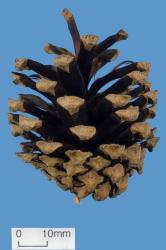- Taxon
- Weed
- Gallery
Medium-sized to large tree; crown ± flattened in mature and older trees. Bark fissured and grey on lower trunk, becoming reddish or orange-brown and flaking on upper trunk. Shoots light yellow, yellowish brown or light brown, glabrous. Buds cylindric-ovoid, reddish brown, not or slightly resinous; scales free at tips. Lvs 2 per fascicle, 2.5–7 cm × 1–1.5 mm, ± twisted, fairly rigid, nearly always bluish green; resin canals ± marginal; sheaths becoming very short. ♂ strobili c. 5 mm long, ± cylindric. Conelets stalked; scales mucronate. Cone stalks short and recurved. Mature cones ± pendent, deciduous, falling intact, 3–6 × 1.5–3 cm when closed, cylindric- oblong or cylindric-ovoid, light brownish grey, symmetric or slightly asymmetric; apophyses ± elongated and tending to curve towards base; umbo not armed. Seed wing asymmetric, < 1 cm long.
[From: Webb et al. (1988) Flora of New Zealand. Volume 4.]




